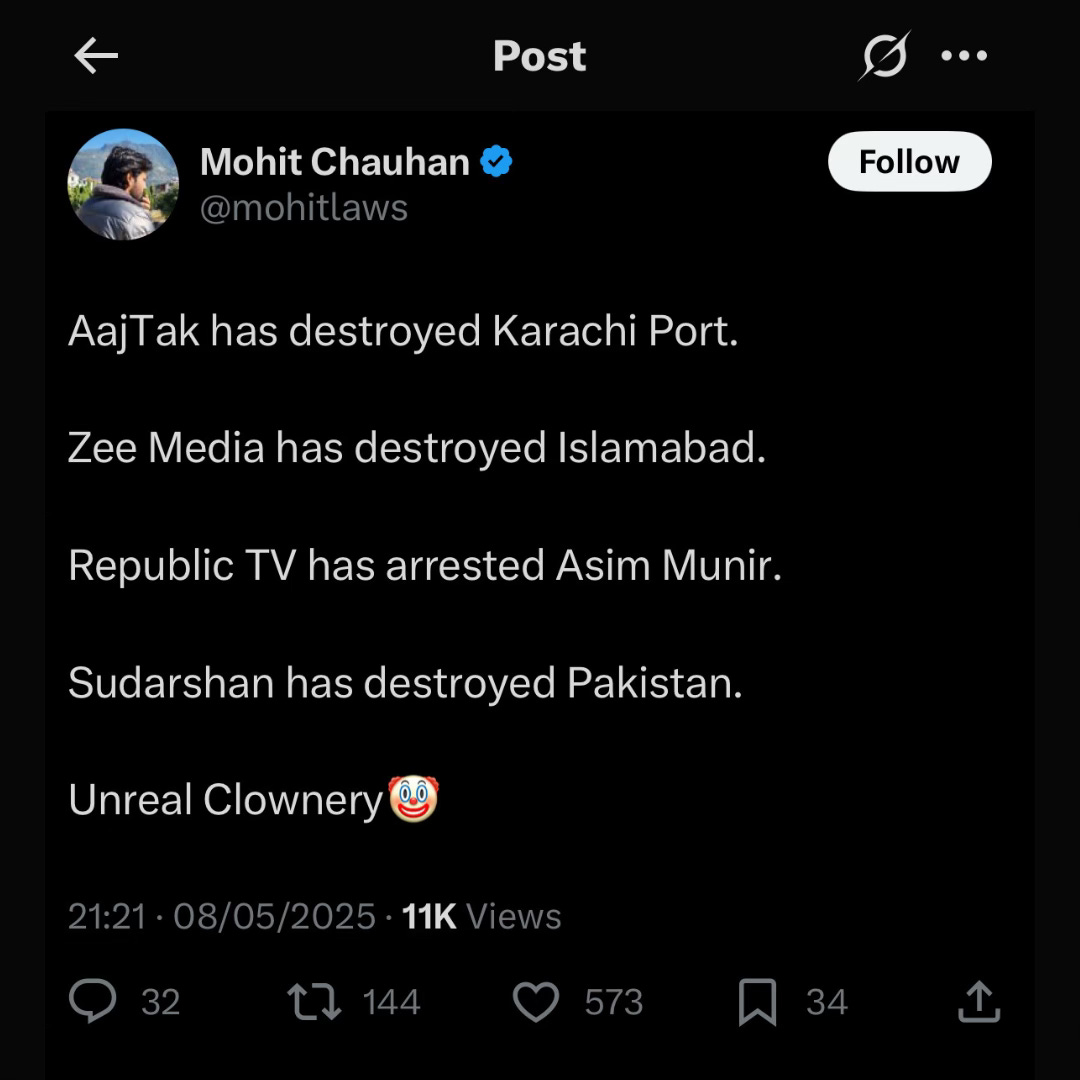Breaking Confusion: Media Hysteria When India and Pakistan Exchanged Fire
A guide for Indians in three parts.
This is a dynamic document and will be updated as needed. Skip to section 3 if pressed for time.
1. On the Frontlines of Information Chaos
On the night of 8th May, my father while bidding me goodnight said in Kannada, "badakthino ilvo" which means, "will I be alive or not?" A friend of mine, holidaying far away from the India-Pakistan border in Meghalaya thought he should cancel his vacation and return home. Both of these people are based in Bengaluru. They were responding to the extreme uncertainty, anxiety, and panic-provoking tactics of the Indian television news corps at a time when India and Pakistan were ratcheting up hostilities.
As per usual, TV news was swollen with speculation and sensationalism. Early on 9th morning, I came across the following lines in a post on social media which summed up the hysteria.
Not that social media was any better. People on X (formerly Twitter) competed with each other as to who would come across as more unhinged and spread baseless information. Even the post above—damning though it is—was circulated by a person who knows the art of persuasion and rhetoric.
I work at a fact-checking organisation where I focus on critical thinking, digital and media literacy, and sifting through notions of news, analysis, opinion, propaganda, and unreliable information. In hindsight, even I didn't know what was happening. So if I, with access to better quality information, did not know what was happening, how could anyone else? Probably no more than a dozen people in India know what is going on right now, and probably that's the same for Pakistan.
And so I thought I should put together this guide for people in times of crisis.
2. Firsthand Strategies: What I Did When Confusion Reigned
I exercised caution on X (Twitter). I did not trust accounts with blue ticks because they can be paid for, unlike in earlier times. I only went to people I know who were tweeting out responsible information.
Tip: ask the sensible people in your life as to who they follow. I followed the likes of Shreya Dhoundial, a defence reporter.Seek out official sources on X (Twitter). I rotated between various Indian government agencies, the handles of various security forces in India, to see what operational information they were giving out.
Tip: type in names of ministers, or ministries on X. For example, here’s the link to the Ministry of Defence handle. Notice the grey tick, which can only be used by government-affiliated accounts.I focused my efforts on newspaper websites. I went to The Hindu website and The Indian Express website, and I did a sweep of other newspaper websites. They were by and large sober in their reportage.
I did a sweep of all TV channels. That's how I saw all the hysteria, but I settled on one channel. This was NDTV, and Vishnu Som’s sober analysis was at least watchable. But the thing with TV news networks is that they are forced to stay in ‘24-hour mode’ which means a repeat of visuals and the same talking points. NDTV too was no different in this regard.
For example, NDTV was found to have carried false news as well, as this tweet indicates.I kept an eye on fellow fact-checkers, my own colleagues at BOOM, and other fact-checking organisations that I know of.
So this is how I coped with what was a very volatile situation. I must also admit that I spent most of my time arguing with my classmates and exhorting them not to watch TV news and not to believe anything they saw on social media.
3. Practical Guidelines for Citizens
Building on the firsthand strategies shared above, here are additional approaches for navigating information during conflicts:
1. Question Initial Reports
First reports during conflict are often incomplete or deliberately misleading.
Wait for multiple confirmations before accepting casualty figures or military success claims.
Remember that even professional fact-checkers struggle with certainty during active conflicts.
2. Identify Media Behaviour Patterns
Notice when TV channels begin competing for who can be most sensational.
Be wary of "breaking news" that remains breaking for hours without new information.
Recognise when opinion is being presented as fact.
3. Watch for Telltale Signs of Propaganda
Exaggerated claims of military success.
Dehumanisation of the opponent.
Absence of nuance or complexity.
Appeal to extreme nationalism.
Lack of verifiable details.
4. Use Digital Tools Wisely
Use caution when trying Google Lens or reverse image searches. You might inadvertently put up personal information online.
Follow fact-checking organisations.
Look for metadata that can verify when and where media was created.
5. Seek Multiple Perspectives
Compare reporting from both sides of the conflict.
Consult international observers and neutral third-party analyses.
Look beyond headlines to detailed analysis from regional experts.
Remember, the real damage of information warfare isn't just misinformation—it's the psychological toll on citizens and the very real danger that sensationalistic reporting can cause citizens to take harmful decisions.





